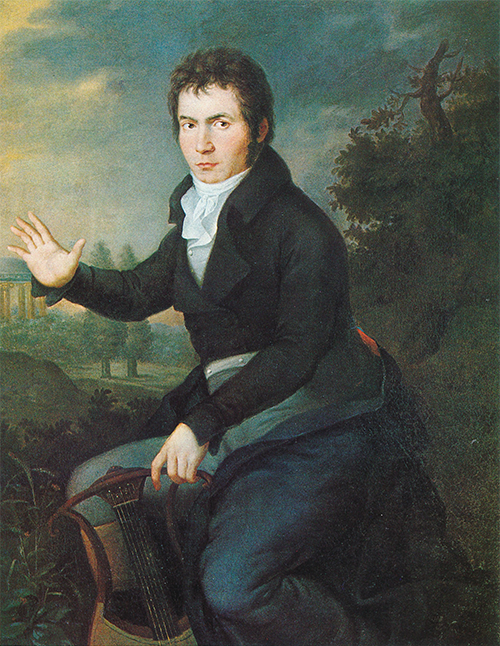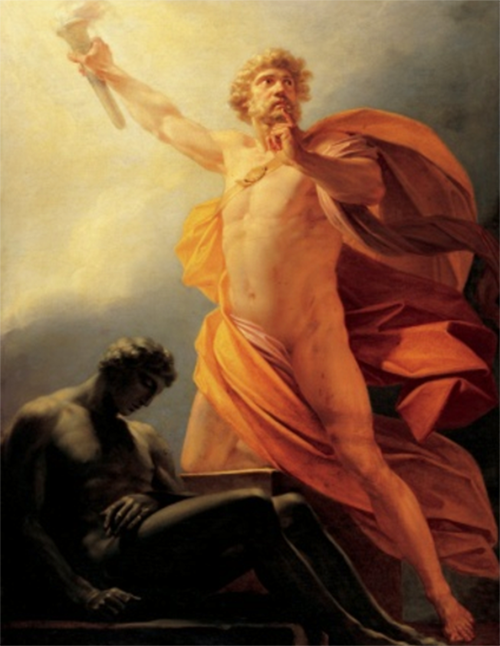
Beethoven: The Prometheus Connection
By Alexander Lawler

“Persevere, do not only practice your art, but endeavor also to fathom its inner meaning; it deserves this effort. For only art and science can raise men to the level of gods.”
— Ludwig van Beethoven in a letter to Emilie M. [surname unknown], 18121
In 1812, Ludwig van Beethoven received a letter from a young pianist named Emilie M. Her letter, enclosed with a home-made embroidered pocketbook, expressed her fondness for, and appreciation of, his music. Taking this gesture to heart, Beethoven responded with a heartfelt missive in which he, in a mentor-like way, described his conception of art and humanity. The quote above, taken from the start of the letter’s central paragraph, is remarkable for its concise explication of Beethoven’s Promethean ideas about the power of art to transform humanity and society.
Prometheus was the last of the Titans in Greek mythology. He sided with the younger upstart gods, led by Zeus, in their war against the Titans. After this war, Prometheus showed sympathy with, and loyalty to, another downtrodden group, humanity. To aid them, Prometheus shared the secrets of fire so that they might raise themselves up from the earth like the gods. The myth differs in each telling — some have Prometheus sharing other secrets, such as art or metalworking, and some, that Zeus took away fire from the humans and Prometheus stole it back for humanity — but virtually all agree that it was the fire of Prometheus that illuminated humanity and allowed civilization to develop.

For Beethoven, the story of Prometheus held an answer to the question of how to reform society and uplift mankind. As Friedrich Schiller, an older contemporary philosopher-poet whom Beethoven read and admired (and would later immortalize in the “Ode to Joy”), argued in On the Aesthetic Education of Man (1794): Political revolution could not bring about a transformation of society but that only aesthetic education, an appreciation of “The Good, The True, and the Beautiful” as found in Art could do so.2 Central to this was the metaphorical figure of Prometheus, an enlightened figure who could guide others by sharing with them the gift of fire. Beethoven saw himself as such a figure, and sought through his music to expose his listeners to higher emotions and higher ideals: freedom, human rights, and an appreciation of the wonder, beauty, and joy of the world.
It is this conception of Beethoven and his music that inspired The Cleveland Orchestra’s Prometheus Festival. Music Director Franz Welser-Möst has described his conception of Beethoven’s music as a “philosophy put into sounds” inextricably entwined with this Promethean ideology. To that end, the core of the festival is a Beethoven cycle: performances of all nine symphonies, as well as four other significant orchestral pieces. Each work has a different connection to Prometheus and a different message for us to consider.
- 1 As found and discussed in Lewis Lockwood, Beethoven: The Music and the Life (New York: W.W. Norton, 2005), 9.
- 2 Jan Swafford, Beethoven: Anguish and Triumph: A Biography (New York: Houghton Mifflin Harcourt, 2014), 266.
- Alexander Lawler worked for the Orchestra’s Archives over three seasons while working on a Historical Musicology PhD at Case Western Reserve University. First writing the “From the Archives” online essays in the 2015/16 season, next designing a photo digitization and metadata project in the 2016/17 season and finally, in the 2017/18 centennial season with the Prometheus Project.
Essay & Audio Library

Beethoven: The Prometheus Connection
In 1812, Ludwig van Beethoven received a letter from a young pianist named Emilie M. Her letter, enclosed with a home-made embroidered pocketbook, expressed her fondness for, and appreciation of, his music.
Continue Reading
Overture to The Creatures of Prometheus
Perhaps the most overt example of Beethoven’s interaction with the idea of Prometheus was his only published ballet, The Creatures of Prometheus.
Continue Reading
Symphony No. 1
In the mainstream history of Beethoven, his early works are more classical in style, hewing close to Mozart and (especially) Haydn.
Continue Reading
Symphony No. 3
Beethoven’s Third Symphony, the Eroica, or “Heroic,” is one of the most influential pieces of music in history.
Continue Reading
Egmont Overture
Beethoven’s Egmont Overture is one of his many concert overtures depicting different kinds of heroic individuals.
Continue Reading
Symphony No. 4
Beethoven’s Fourth Symphony seems an anomaly compared to the heroic Third and the fateful Fifth.
Continue Reading
Symphony No. 7
In the Seventh, Beethoven suffuses each movement with a unique and persistent rhythmic pattern.
Continue Reading
Overture to Coriolan
Beethoven’s Overture to Coriolan is the only tragic piece in our Prometheus Festival. Indeed, in spite of the intense conflict that marks much of his music, Beethoven was something of an optimist.
Continue Reading
Symphony No. 5
Beethoven’s Fifth Symphony is so familiar to us now that it might be difficult to imagine it as shocking or difficult.
Coming Soon
Symphony No. 8
The Eighth Symphony generally has been regarded as the slightest of Beethoven’s mature symphonies because of its short length, lighter tone, and frequent return to the musical styles and forms of the eighteenth century.
Coming Soon
Leonora Overture No. 3
Fidelio (1805), Beethoven’s only opera, is a celebration of freedom. In the opera, Florestan has been imprisoned by the tyrant Don Pizarro.
Coming Soon
Symphony No. 9
Beethoven’s Ninth Symphony stands as the culmination of Beethoven’s twenty-four-year career as a composer of symphonies.
Continue Readingf
Symphony No. 2
Beethoven first realized he was becoming deaf in the summer of 1798, at age twenty-seven. After an initial episode of total deafness, Beethoven found that his hearing had become filled with an unending “maddening chorus of squealing, buzzing, and humming.”
Coming Soon